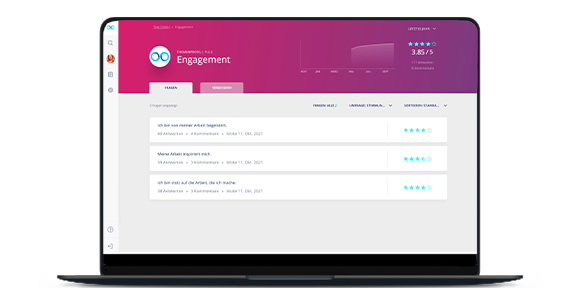
Why Engagement Surveys are only the start
14.02.2022
Christian Kaller
By now, most organizations have understood: Current business environments are increasingly dynamic and so complex that they require agility and rapid innovation cycles. Feedback is a central part in this. In a nutshell: The higher the feedback frequency, the faster an organization can react to external and internal changes and the more agile an organization is.
More and more organizations are thus implementing digital tools for regular engagement surveys as part of their management mechanism. That’s an important step towards more internal transparency and more efficient people management. But: Stopping here falls short of realizing the most exciting potential of regular, recurring feedback.
Why? Once the digital toolset for it is implemented, recurring feedback unlocks new opportunities to help teams and individuals increase productivity. To realize this, feedback content needs to become more operational and HR needs to hand over control to teams and individuals.
In order to define operational feedback, we’ll look at several different feedback modes along the dimensions of organizational level and content orientation. In the following, we’ll discuss the underlying concepts and give examples for practical applications of operational feedback.
Content: From assessment to operational support
The main differentiator between developing feedback and operational feedback is the temporal proximity between the expected improvement from receiving feedback to the concrete underlying tasks/content. In order to be operational, feedback should fulfill two conditions: It should be a) directly (=quickly) applicable and b) not assessing. “Classic” developing feedback almost always has an assessment (and thus judging) component and a comparably long time horizon to implement measures resulting from the feedback – examples are employee satisfaction surveys and performance appraisals. Operational feedback cuts the assessing dimension and clearly focuses on small, iterative improvements of collaboration and target achievement that can be implemented in the short term.
Example for operational feedback 1: Manager Self-Check
Once a month, managers receive feedback from their team members on three questions:
- My current priorities are clear
- I have enough 1:1 time with my manager
- I feel like my manager understands my current challenges
Important: Only the manager herself sees the answers (no access for HR!), responding is voluntary. This way, feedback transforms into directly applicable, active leadership support. If I as a manager see that one of my team members needs more time with me, I can directly act on it.
Contrasting this with a „classic“ manager 360° feedback with competency dimensions, development focus and HR moderation shows the time and content based differences to operational feedback.
Organizational level: From the HR department to teams
The second prerequisite for operational feedback: It needs to be close to the parties that are actually acting on specific tasks. Currently, most organizational feedback is controlled and analyzed by HR departments or company leadership. For operational feedback, centralized control outside of supporting system implementation makes little sense though.
To create value on all levels of the organization, feedback should follow agile principles and ideally be used, controlled and analyzed where people directly affected by it can act on it. In other words: Control over feedback belongs in the hands of teams and individuals. This works best with a high degree of automatization. Regular feedback that’s being run “in the background” doesn’t disrupt workflows or demands habit changes – which in turn increases adoption.
The example above showed how operational feedback can give managers valuable impulses for adjusting their leadership directly. The following example hopefully demonstrates the value operational feedback can create for teams.
Example for operational feedback 2: Team-Barometer
Once a month, teams anonymously answer 5-10 questions about their collaboration, e.g.:
- Do we currently have blockers? Which ones?
- Is communication in our team working?
- Are we on track regarding work-life-balance?
- …etc. (feel free to contact us for best practice examples, we’re happy to help!)
Again, questions should be designed to not be assessing/judging and answers should be analyzed within the team. Once pain points are identified, team members can talk about how to counteract them - without delay and without the need for HR or company leadership to initiate measures “from above”. Especially for distributed teams where all or some team members work remotely, this can massively increase efficiency. Some advantages:
- Separating the collection of responses from the (joined) analysis of answers transforms long winded video calls to solution oriented meetings with a basis in concrete and hones data.
- Shy team members are not being overlooked but have a voice with as much weight as more extroverted members.
- Problems are identified and corrected before they spiral out of control
Combined with a result oriented goal management, this can massively help with creating a productive and pleasant work environment. An additional advantage: If HR has access to these (anonymous!) results, a broadly used team barometer can make centrally managed engagement surveys obsolete – the corresponding data is created as a byproduct.
Summary: The impact of operational feedback
If organizations want to take full advantage of their digital feedback tools, it makes a lot of sense to ask at every step of the value chain: Where can we use feedback to shorten iteration cycles. HR departments with their core competency of organizing feedback can create enormous value for other departments by providing tangible results of regular feedback directly to teams and individuals.
Our experience with implementing our solution for operational feedback LoopNow has shown a whole range of advantages for organizations deploying it:
- Increased productivity by automation and desynchronization of data creation
- Faster reaction speeds by normalizing agile iteration cycles
- More honest opinions by anonymization of responses
- Clearer picture of the situation by eliminating visibility bias (= not only the loudest voices are heard)
- Value of feedback is directly tangible for every single person
Are you interested in operational feedback? Let us know! We help organizations to maximize collaboration efficiency with our customizable digital solutions for feedback, 360° development and OKR management, and our Loopline Academy since 2014.




